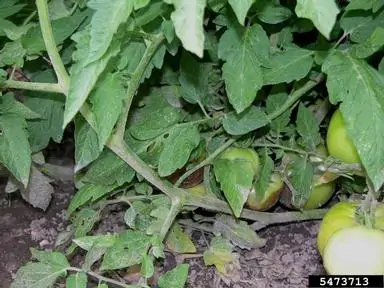Tomato root rot problems are different from other tomato plant problems. So, this is a little bit difficult to find out the actual reason behind the problems because the symptoms are often not directly visible.
Due to root problems, tomato plants may stop growing, wilt, turn brown or yellow color, or some lesions may appear on stems. These symptoms are also very common in other tomato plant problems.
Below are some common tomato root problems and possible solutions.
01- Fusarium Crown and Root Rot
Fusarium crown and root rot are a severe soil-borne fungal disease caused by the pathogen Fusarium oxysporum f. sp. radicis-lycopersici (FORL). Sandy and acidic soil are more susceptible to the spread of the disease.
The disease was first introduced in Florida and then extended to several parts of the United States. It is also found in many countries in North America, Europe, and Asia.
Nightshade family plants, including tomatoes, pepper, and eggplants, are the main host of the pathogen.
Causes and symptoms:
The fungus can spread out in fresh soil from the infected plants during rain and working in the field.
Besides, greenhouses or high tunnels are most susceptible to the disease.
The pathogen performs well in cool weather conditions when the temperature remains between 50°F to 70°F. As well low soil pH and poor drainage systems are also susceptible to diseases.
You may notice seedlings stop growing and start yellowing. Moreover, older leaves turn yellow and fall off earlier.
Dark brown spots appear just above the soil line surrounding the main stem and moving upwards. Besides, you will see brown discoloration inside the plant stem when slicing them lengthwise.
As a result, the plants become wilting and die eventually.
You may also find discolored, rotted, and underdeveloped roots of an infected plant.
Treatments and controls:
- There are no chemical fungicides to control the Fusarium crown and root rot once affected.
- Find some disease-resistant tomato varieties for your garden with the letter ‘F,’ ‘FF,’ or ‘FFF’ printed on the seed packet or plant label.
- The fungus can survive in the soil for up to two years. So, fumigants your garden soil and cover the area with plastic two weeks before transplanting tomatoes.
- Don’t wound your seedlings during transplant, and avoid planting them if they are injured.
- Remove and destroy the remaining plant debris after harvest.
- Keep the soil pH level at 6 to 7.
- Amend your garden soil with compost or organic fertilizer to develop the drainage system.
- Once infected, avoid planting tomatoes and other host plants (pepper, eggplants, wheat, or asparagus) in the same field for the next two years.
02- Root-Knot Nematode of Tomato
Root-knot nematodes (Meloidogyne spp.) are parasites that cause common root problems in tomato, pepper, carrot, lettuce, potato, radish, okra, and other vegetable crops.
It mainly occurs by tiny eelworms during hot weather conditions in the United States and all over the world.
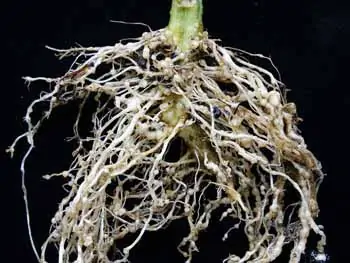
Causes and symptoms:
Tomatoes are more susceptible to root-knot nematodes due to they are warm-loving plants.
Root-knot nematodes perform better in sandy soil in warm weather conditions. But it also attacks in heavy soil.
Nematodes can remain active when the soil temperature goes above 64°F. But they perform well when the temperature reaches 70°F to 90°F.
Tomato plants stop growing and start yellowing or pale green when they attack.
Your tomato plants are prone to wilt even if you provide fertilizer, a regular water supply, and the soil has enough moisture.
The damaged roots are unable to supply water and nutrients to the tomato vine.
If you want to confirm the nematode attack, dig up a particular weak tomato plant, and you will see distinctive galls on the roots.
Nematodes are tiny roundworms that can pierce the roots of tomatoes and other host plants and lay their eggs inside the roots. Lastly, those eggs develop knots in the root system.
Small injuries in tomato plant roots are more susceptible to nematodes. Once infected, gradually, they multiply their numbers and destroy the small feeder roots. Finally, they form irregular galls in the infected roots.
Northern root-knot nematode creates small galls; on the other hand, southern root-knot nematode creates large galls.
Root-knot nematodes can also be spread by human movement or moving infected soil in the field.
Treatments and controls:
- Find some root-knot nematode-resistant tomato varieties by the letter “N” in the seed packet.
- Crop rotation may reduce the risk of root-knot nematodes.
- Amend your soil regularly with seafood meals, eggshells, or shrimp hulls. These ingredients contain chitin which feeds the microorganisms that chow down on chitin. It also chows down the nematode eggs.
- Remove the poorly infected tomato plants, including the surrounding soil, about 7 inches deep, and burn them. It may work because nematodes can’t move far in the soil, and overheating can kill them.
- Avoid the area where the infected tomato plants grew. Don’t grow tomatoes and other host plants in the infected area again for several years.
- Soil solarization before the season may also work to kill the nematodes with extreme heat.
03- Phytophthora Root Rot of Tomatoes
Phytophthora root rot of tomato is caused by a soil-borne fungus-type water mold usually known as Phytophthora nicotiana, Phytophthora nicotianae var. nicotiana, or Phytophthora parasitical or P. capsici. They are actually related to algae, not fungus.
This disease is distributed all over the world and also infects capsicum, papaya, pineapple, citrus, and tobacco.
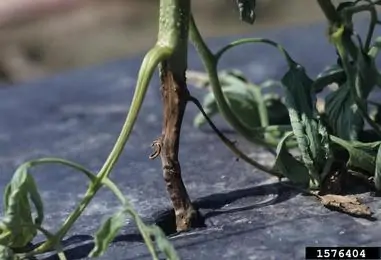
Causes and symptoms:
Phytophthora performs better when the temperature reaches 77°F to 82°F.
Waterlogging situations due to heavy rainfall, poor drainage system, or prolonged irrigation can cause the problem.
This water mold can survive in the soil as resting spores called “sporangia” until the right condition come.
While the soil is saturated, the sporangia release some swimming spores, which can reach the tomato plant root and develop the disease.
In the beginning, Phytophthora creates brown lesions on tomato roots and gradually girdles all roots.
Soon the plants stop growing and start wilting. This work becomes easier if they get hot weather.
Moreover, when the fruits touch the ground, they are also infected by Phytophthora, which is commonly known as buckeye rot. They can also create greasy or purple-brown lesions on tomato plant stems.
Treatments and controls:
- Find some diseases resistant tomato varieties compatible with your local climate.
- Check the soil moisture before watering each time.
- Maintain schedule watering and keep monitoring the soil condition during the rainy season.
- Furrow irrigation, drip irrigation, bottle irrigation, and other tomato irrigation methods may solve the problem.
- Proper soil amendment and well drainage system also help to reduce the risk of Phytophthora root rot.
- Avoid planting tomatoes in low-lying areas where soil conditions and drainage systems are very poor.
- Every season turn around the tomato growing location in your garden and avoid planting in the infected field for the next 4-5 years.
- Once infected, don’t plant any Solanaceous crops in the infected file. Because Phytophthora spores can survive in the soil for a long time without any host.
- Remove and destroy the infected plants and fruits as soon as you notice them in the garden.
- Wash your gardening tools with hot water. You can also sterilize them with isopropyl alcohol to prevent the diseases from spreading in healthy tomato plants.
- Apply fungicides that contain metalaxyl, mancozeb, copper, chlorothalonil, or protectant fungicides for poorly drained soils as a foliar spray when fruits grow one-third of their matured size. Keep continuing spraying at 1-2-week intervals if the rain falls.
04- Corky Root Rot of Tomato
Corky root rot is a common soil-borne fungal disease of tomato plants caused by the pathogen Pyrenochaeta lycopersici.
This fungus is commonly found in the United States, Canada, Europe, and New Zealand.
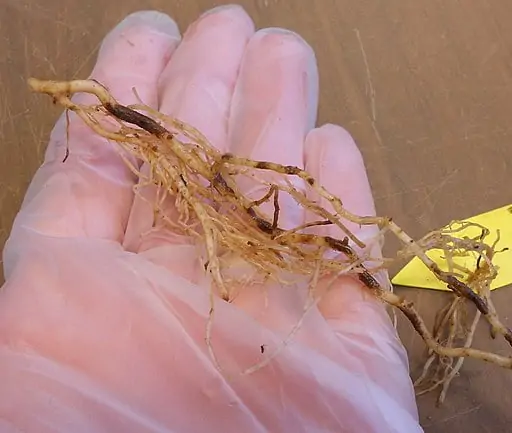
Causes and symptoms:
Corky root rot usually happens for early planting when the temperature is cool, and the condition is not suitable for planting tomatoes.
The disease can perform well when the temperature remains at 60°F to 68°F.
The infected plants may stop growing. They start wilting during the day and premature defoliation.
At first, light brown areas come into sight on the thin root.
As the disease expands, larger and older roots are infected.
In this stage, they develop extensive brown lesions that are arranged slightly swollen with lengthwise cracking of the cortex, and finally, the roots show a corky appearance.
In the meantime, small feeder roots can be fully rotted away. Moreover, the taproot of your tomato plant and stem base ultimately turns brown and rot.
This disease eventually doesn’t kill the tomato plants but rather reduces the yield.
Treatments and controls:
- Plant tomato seedlings when the nighttime soil temperature is constantly above 55°F to 60°F and the daytime temperature above 70°F.
- Rotate the crop cycle and avoid tomatoes along with other host plants like safflower, peppers, potatoes, eggplants, and cucurbits.
- Soil solarization may work to control corky root rot on tomatoes.
- If you are confirming that your field is previously affected by corky root rot, then you may use metam sodium for soil fumigation before planting tomatoes and other host plants.
05- Damping Off Tomato
Damping off in tomatoes is a severe fungal disease caused by the pathogens Phytophthora, Pythium, and Rhizoctonia spp.
These pathogens can rot tomato seeds before germination or cause poor germination. Besides, it also attacks the tender stems and roots of tomato plants.
Cool and wet weather condition is suitable for the pathogen to infect the plants. However, it can also attack in warm conditions.
Once the pathogen appears, there is no treatment for the infected plants, so prevention is better than cure.
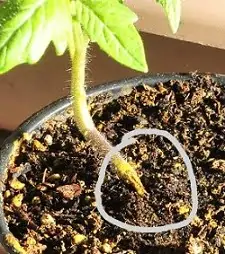
Causes and symptoms:
The disease can attack in two stages, such as a pre-emergence and post-emergence period.
Younger plants are mainly attacked by the pathogen; however, older plants also are affected.
In the pre-emergence period, pathogens Pythium and Rhizoctonia may attack the seeds before sprouting or rot the seedlings before they reach from soil surface up to the 2-3 leaf stage.
In the post-emergence period, the pathogen Phytophthora can attack after sprouting at any stage of plant growth, and dark water-soaked lesions develop at the bottom of plant stems. Ultimately, plants lie down on the ground as if someone cut down the base of the stems and died off.
Highly humid and moist soil condition with cloudy weather is more susceptible to the disease.
The pathogens perform better when the temperature remains constant below 75° F.
Treatments and control:
- Preparing your seedbeds with a proper drainage system is essential to reduce the risk of the disease. Use sprinklers or hand water sprayers to provide and control water on your seedbeds.
- Transplant your seedling when the soil temperature goes above 77°F.
- The indoor temperature of the seedbeds must be warm enough for healthy germination and to prevent damping off.
- Arrange adequate air circulation in your seedbeds to absorb the extra moisture of the soil.
- Remove and destroy the infected plants as soon as possible when they appear.
- Use organic potting soil mix and sterilize it by heating it in an oven.
- Sow seeds lightly in seed trays to avoid susceptibility to the moist condition.
- You can apply biological control using copper fungicides.
- Besides, apply chemical treatments to sterilize seeds and use foliar spray during susceptible weather conditions.
- You can get more and more exact instructions from your local extension center about damping off.
Read More:
*** 7 Basic Reasons Behind Common Tomato Plant Problems
*** 5 Common Tomato Stem Problems and Solutions
*** 15 Common Tomato Fruit Problems and Solutions
*** 10 Common Tomato Leaf Problems and Solutions
Sources and Citations:
- https://extension.umn.edu/diseases/fusarium-crown-and-root-rot
- https://www.growveg.com/plant-diseases/us-and-canada/tomato-root-knot-nematodes/
- https://content.ces.ncsu.edu/control-of-root-knot-nematodes-in-the-home-vegetable-garden
- http://ipm.ucanr.edu/PMG/r783100511.html
- http://ipm.ucanr.edu/PMG/r783100611.html
- https://www.seminis-us.com/resources/disease-guides/tomatoes/corky-root-rot/

